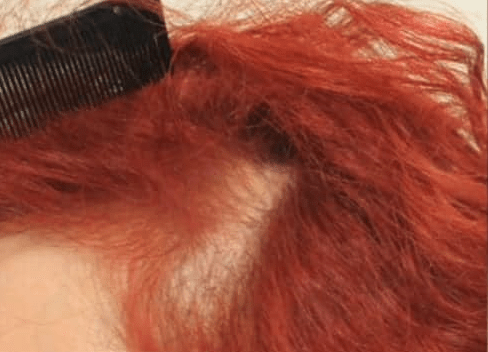Traction Alopecia Edge Loss Can Affect All Ethnicities

Traction alopecia is often associated with women of African descent due to the modern cultural use of tightly pulling hair-styling practices such as:
- Box braids
- Weaves
- Extensions
- Lace-front wigs
- Cornrows
- Ponytails
- Deadlocks
- Caucasians
- Asians
- Hispanics
- Middle Easterns
- Etc.

Tension based hair loss has also been affecting a greater number of celebrities, largely due to their reliance on hair extensions and tight, sleek ponytails. Rumored examples include:
- Naomi Campbell
- Kim Kardashian
- Arianna Grande
Is Traction Alopecia Reversible?
It is possible for sufferers of traction alopecia to reverse their condition if their hair follicles are still capable of producing new hair growth. Constant tension (due to hair pulling) inflicts mechanical damage to the hair follicle. This then triggers the body’s inflammatory processes. The early stages of TA are often marked by small raised bumps on the scalp. Also, a greater proportion of hair follicles transition from their active anagen growth stages to enter a transitional period known as catagen before finally graduating into a resting, non-growth phase known as telogen. Early to mid-stages of traction alopecia are reversible through early detection, the use of effective topical treatment, and the adoption of safe, relaxed hairstyles. On the other hand, if the condition is allowed to progress to more severe stages, permanent scarring fibrosis then gradually replaces the hair follicles themselves. At this point, no new hair can be produced.The Natural Power of Plants Offers New Hope For Qualified Traction Alopecia Cases
Again, the key to reversing traction alopecia is early intervention when the hair follicles have not yet lost their capacity to construct new hair shafts. During these earlier stages, it is possible to subdue inflammatory processes and heal mechanical damage inflicted on the hair follicles. Research is now finding that various plant types wield the capacity to treat inflammation, improve circulation, ward off age-promoting oxidative stress, and even boost the overall health of the hair follicles, helping more of the return to the active anagen growth phases. However, the potential of these healing capabilities can only be realized through specialized processes that preserve the integrity of the bioactive properties held within the original plant, as intended by nature. Using the right methods and techniques to improve these aims, it is then possible to harness the potential of plants to improve the well-being and vitality of the hair follicles themselves, and even reverse early to mid-stage manifestations of traction alopecia. By incorporating this knowledge into all-natural product formulations dedicated to hair and follicular health, Dr.UGro Gashee is poised to help qualified female and male TA sufferers get a second chance at achieving more youthful forms of hair growth. Edge loss due to traction alopecia can be scary, but not necessarily hopeless. Here’s proof.

Diane suffered from a combination of traction alopecia and CCCA (Central Cicatricial Centrifugal Alopecia) She lost hair on both her edges and other regions of her scalp. Although Diane’s condition was past the earliest initial stages of traction alopecia hair loss, she was still able to recover normal and impressive looking coverage after using our line of products.
Diane’s amazing success story goes to show that it is certainly possible to reverse traction alopecia hair loss using the therapeutic healing potential of plant-based medicine. Many cases of Traction Alopecia can be reversed using well-formulated, natural products
The experience of seeing renewed hair growth is healing and uplifting to a person’s soul and spirit. Helping people get their edge back and achieve new milestones is something that gives us joy and fulfillment as hair scientists. We realize that it is a natural human desire to see one’s self as attractive and beautiful. It cannot be argued that our hair plays a huge role in how we construe our self-image when we see ourselves in the mirror. If you feel inspired by Diane’s story and would like to learn about other Gashee True Life stories, click here to learn more.




